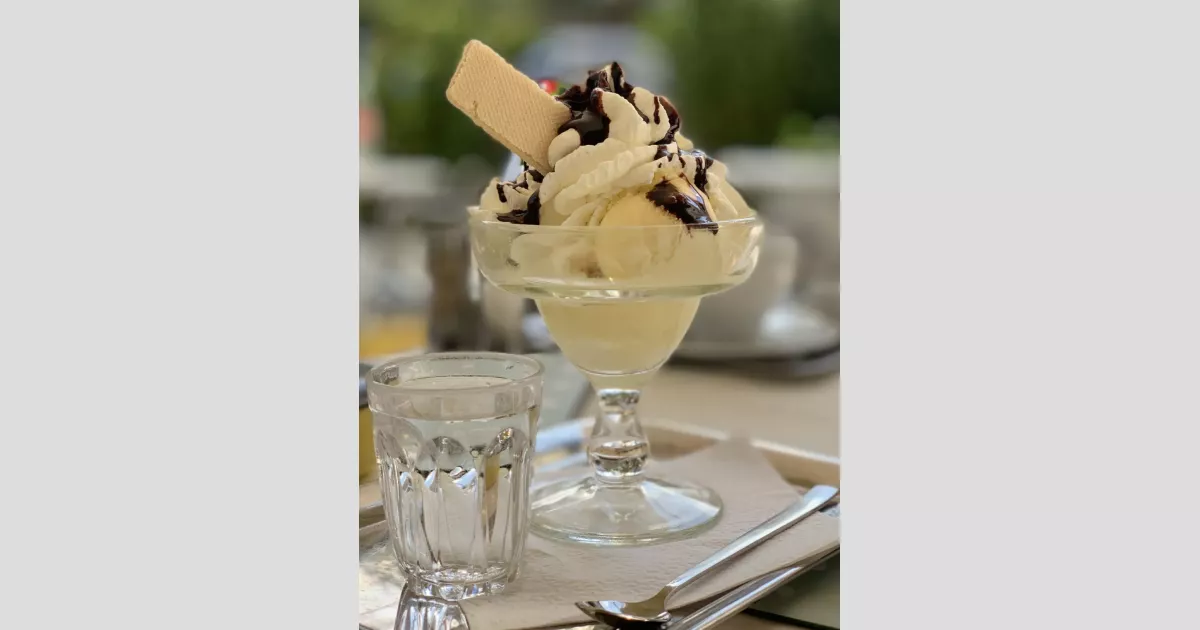Ice cream is a frozen dessert primarily composed of milk or cream, sweetened with sugar or alternatives, and flavored with spices like vanilla or cocoa, or fruits such as strawberries or peaches. Food coloring and stabilizers may be added. The production process involves cooling the mixture below freezing while stirring to introduce air and prevent large ice crystals. An alternative method uses a flavored cream base combined with liquid nitrogen. The final product is a smooth, semi-solid foam that is solid at low temperatures, becoming more pliable as it warms.
1904: Ice cream cone popularized at World's Fair
In 1904, the ice cream cone was popularized in the US at the World's Fair in St. Louis, Missouri.
1904: Ice cream cone popularity increased during the St. Louis World's Fair
The popularity of ice cream cones greatly increased during the St. Louis World's Fair in 1904, due to a vendor running out of cardboard dishes and using waffles instead.
1926: Freezer perfected; mass ice cream production begins
In 1926, the freezer was perfected, leading to commercial mass production of ice cream and the modern ice cream industry.
1996: Food Labelling Regulations set requirements for ice cream in the UK
In 1996, the Food Labelling Regulations in the United Kingdom established a minimum requirement of 5% milk fat and 2.5% milk protein for a product to be sold as ice cream.
2006: Liquid nitrogen used for primary ice cream freezing
In 2006, some commercial ice cream makers began using liquid nitrogen in the primary freezing of ice cream, eliminating the need for a conventional ice cream freezer.
2008: Vanilla and chocolate top ice cream flavors in U.S.
As of 2008, vanilla and chocolate were the most popular ice cream flavors in the U.S., holding a combined market share of 40%, according to the NPD Group.
2015: Study links emulsifiers to health issues
In 2015, a mouse study suggested that carboxymethyl cellulose (CMC) and polysorbate 80 (P80), two commonly used dietary emulsifiers, could potentially cause inflammatory bowel diseases, weight gain, and other metabolic syndromes.
2015: UK regulations relaxed on ice cream composition
In 2015, regulations in the United Kingdom were relaxed, making milk fat or protein no longer necessary for a product to be sold as "ice cream", though a 5% milk fat content was still required for "dairy ice cream".
2015: US Ice Cream Production
In 2015, the United States produced approximately 900 million US gallons of ice cream.
2018: Ice cream exports cater to Asian markets with new flavors
In 2018, New Zealand's exported ice cream products expanded to include new flavors like matcha, specifically to cater to Asian markets.
2024: UK ice cream market worth £1.8 billion
According to a report produced in 2024, the ice cream market in the United Kingdom is worth £1.8 billion, with 14 million adults buying ice cream as a treat.
Mentioned in this timeline
New Zealand is an island country located in the southwestern...

St Louis is an independent city located in Missouri near...

Liquid nitrogen is nitrogen in liquid form at very low...

September is the ninth month of the year in the...
Trending

2 months ago Cuomo rebuked after Mamdani-Vance 9/11 remark sparks controversy; Mamdani responds to Islamophobia claims.

2 months ago [TO_BE_ADDED_BY_AI]

Microsoft an American multinational technology corporation headquartered in Redmond Washington was founded in It gained prominence with its Windows operating...
3 months ago Colorado I-70 Traffic Gridlock: Georgetown Reopens After Leaf-Peeping Blockade and Delays.
2 months ago Jason Clarke stars in 'The Last Frontier,' an Alaskan adventure series on Apple TV+.

1 month ago Ubisoft's Anno 117 includes AI art placeholder; Fans react negatively.
Popular

XXXTentacion born Jahseh Dwayne Ricardo Onfroy was a controversial yet...

Ben Shapiro is a prominent American conservative political commentator media...

Candace Owens is an American conservative political commentator and author...

William Franklin Graham III commonly known as Franklin Graham is...

Tucker Carlson is an American conservative political commentator known for...
The Kennedy Center Honors are annual awards recognizing individuals and...
